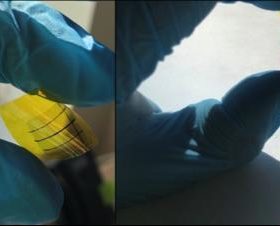
The new cell is based on a p-type transparent conductor made of carbon nanotube fibers. Compared to current realized efficiencies of amorphous cells, that of the new device is said to be 16% higher.
Scientists led by the Laboratory of Nanomaterials at the Skoltech Center for Photonics and Quantum Materials (CPQM) in Moscow claim to have developed a solar cell based on amorphous silicon with an efficiency of around 8.8%.
This achievement, the researchers explained, was made possible by a novel p-type flexible transparent conductor made of carbon nanotube fibers, which enabled the manufacturing of the amorphous cell at room temperature.
“We have progressed from the initial 1.6% and 3.4% reported previously in 2016 and 2018 respectively to 8.8% in 2019 using our newly developed p-type transparent conductor for such hybrid thin film solar cells,” said Skoltech Ph.D student Pramod M. Rajanna.
The device is described in a paper published in Nano Energy. The scientists claim this is an increase of around 16% over currently realized efficiencies for amorphous silicon solar technology. According to ScienceDirect, these efficiencies currently range between 6% and 7%, while the theoretical limit for amorphous silicon cell efficiency is estimated at about 15%.
“We have developed a p-type transparent conductor with a state-of-the-art sheet resistance of 17 Ω/sq at a transmittance of 90% in the middle of the visible spectrum and a high degree of mechanical flexibility,” the research team asserted.
The global market for amorphous silicon thin-film solar cells is likely to reach $5,310.2 million by 2025, according to a report from U.S.-based Energias Market Research Pvt. Ltd. “Traditionally, amorphous silicon thin-film solar cells were mainly used in small electronic devices due to their simplistic design and low efficiency. However, with advancements in manufacturing techniques and an increase in their performance efficiency, these cells have found their application in building integrated photovoltaics,” the company stressed.
“Also, the growing use of carbon nanotubes for charge transport between layers, presents significant opportunity for the market,” it further explained.
Lắp đặt điện mặt trời Khải Minh Tech
https://ift.tt/2X7bF6x
0906633505
info.khaiminhtech@gmail.com
80/39 Trần Quang Diệu, Phường 14, Quận 3
Lắp đặt điện mặt trời Khải Minh Tech
https://ift.tt/2ZH4TRU
Không có nhận xét nào:
Đăng nhận xét